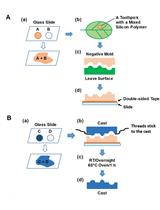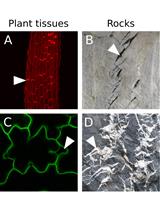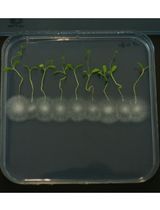- EN - English
- CN - 中文
Determination of the Developmental Origin of Seeds Containing Endosperm Using Flow Cytometric Analysis
流式细胞仪检测含胚乳的种子的发育起源
发布: 2015年06月05日第5卷第11期 DOI: 10.21769/BioProtoc.1484 浏览次数: 9963
Abstract
Seeds derived from a diploid, sexual plant typically contain a 2n embryo (n+n) and 3n endosperm, a ratio characteristic for most flowering plants. However, this ratio is altered in apomictic species, which reproduce asexually through seeds (Koltunow and Grossniklaus, 2003). Apomixis is usually a facultative trait and encompasses several developmental steps: (1) apomeiosis (avoidance of meiosis), (2) parthenogenesis (embryo development without fertilization), and (3) functional endosperm formation (autonomous without fertilization or pseudogamous requiring fertilization). If all three steps occur, this process results in maternal offspring (2n+0), which is genetically identical to the mother plant (clonal). Moreover, sexual and apomictic pathways can occur in the same plant and sometimes they cross over, producing polyhaploid offspring (n+0; resulting from meiosis and parthenogenesis) or BIII hybrids (2n+n; resulting from apomeiosis and fertilization) (Rutishauser, 1947). The different types of offspring can be determined in a flow cytometric seed screen (FCSS), in which the relative chromatin content of stained nuclei is determined by measuring their fluorescence intensity. This allows a comparison of the ploidy of the endosperm to the ploidy of the embryo and, thus, an inference of the pathway by which a seed was formed (Matzk et al., 2000). This method is particularly useful to characterize the developmental origin of seeds in apomictic plants or reproductive mutants of sexual species.
Here, we present the protocol for an FCSS in Brassicaceae that has specifically been adapted to plants of the genus Boechera. However, in principle this protocol can be applied to any species producing seeds that contain endosperm.
Materials and Reagents
- Citric acid monohydrate (Sigma-Aldrich, catalog number: 33114 )
- Triton X-100 (Sigma-Aldrich, catalog number: X100 )
- Na2HPO4.2H2O (Merck KGaA, catalog number: 1.06580.1000 )
- 4’,6-Diamidin-2-phenylindol (DAPI) (Life Technologies, InvitrogenTM, catalog number: D1306 )
- β-mercaptoethanol (Sigma-Aldrich, catalog number: M6250 )
- Sheath fluid; Iso-Diluent
(Beckman Coulter, catalog number: NPE 629967 )
- Cleaning solution (Beckman Coulter, catalog number: 629969 )
- Shutdown solution (Beckman Coulter, catalog number: 629968 )
- Stock solutions (see Recipes)
- Otto 1 solution 0.01% (see Recipes)
- Otto 1 solution 1% (see Recipes)
- Otto 1 solution 0.5% (see Recipes)
- Otto 2 solution (see Recipes)
Equipment
- 1.2 ml Cluster tube and rack (sterile) (Thermo Fischer Scientific, catalog number: 07-200-320 )
- Storage plate cap strips (Thermo Fisher Scientific, catalog number: AB-0981 )
- 3 mm stainless steel beads (Schieritz & Hauenstein, catalog number: 22.455.0011 )
- Nunc Fritted deep well plates (Thermo Fisher Scientific, catalog number: 278011 )
- 96-well V-bottom plates (SARSTEDT AG, catalog number: 82.1583.001 )
- 200 μl tips (SARSTEDT AG, catalog number: 70.760.002 )
- 1 ml tips (Rainin/Mettler Toledo, catalog number: RC-1000/10 )
- Single channel pipettes (Gilson, catalog number: P10 , P1000 )
- Multichannel pipette 10-100 µl (Thermo Fisher Scientific, catalog number 4661130 )
- Multichannel pipette 30-300 µl (Thermo Fisher Scientific, catalog number 4661140 )
- Mixer mill (Retsch, model: MM300 )
- Centrifuge (Eppendorf, model: 5810R )
- UV lamp (part of 13. flow cytometer)
- Flow cytometer (Beckman Coulter, Cell Lab Quanta SC, serial number: AN020010 )
- Flow cytometer robotics (Beckman Coulter, MPL, Cell Lab Quanta SC, serial number: AN90022 )
Procedure
文章信息
版权信息
© 2015 The Authors; exclusive licensee Bio-protocol LLC.
如何引用
Sailer, C., Schmidt, A. and Grossniklaus, U. (2015). Determination of the Developmental Origin of Seeds Containing Endosperm Using Flow Cytometric Analysis. Bio-protocol 5(11): e1484. DOI: 10.21769/BioProtoc.1484.
分类
植物科学 > 植物细胞生物学 > 组织分析
细胞生物学 > 基于细胞的分析方法 > 流式细胞术
您对这篇实验方法有问题吗?
在此处发布您的问题,我们将邀请本文作者来回答。同时,我们会将您的问题发布到Bio-protocol Exchange,以便寻求社区成员的帮助。
提问指南
+ 问题描述
写下详细的问题描述,包括所有有助于他人回答您问题的信息(例如实验过程、条件和相关图像等)。
Share
Bluesky
X
Copy link













